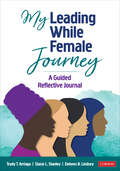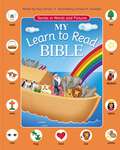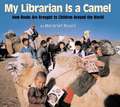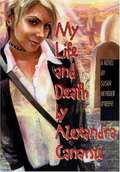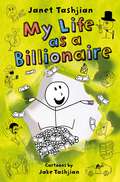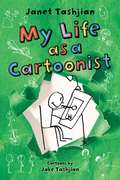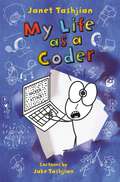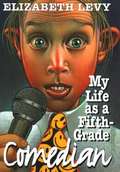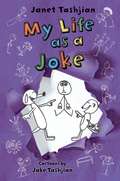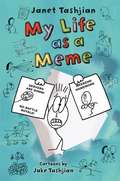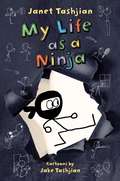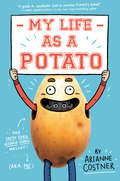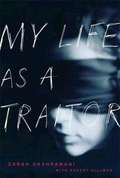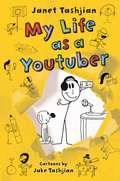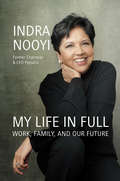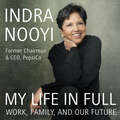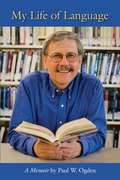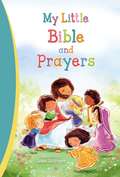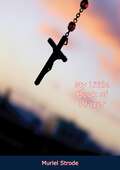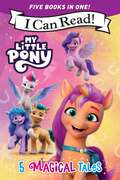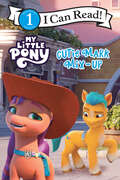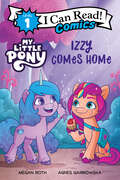- Table View
- List View
My Leading While Female Journey: A Guided Reflective Journal
by Trudy Tuttle Arriaga Stacie Lynn Stanley Delores B. LindseyWomen leaders explore personal and professional growth through reflection and story Leading While Female means working with female and male colleagues who are grounded in values for equity to confront and close the gender equity gap. This guided reflection is both a stand-alone book and a companion to the bestselling Leading While Female: A Culturally Proficient Response to Gender Equity. Combining the first-hand experiences of female leaders with research on feminism, intersectionality, and leadership, Arriaga, Stanley, and Lindseysupport readers to explore their personal and professional cultural proficiencies. Readers will find: support to identify barriers and formulate methods to overcome them, opportunities to record their experiences following a narrative protocol for their Stormy First Draft (SFD), a writing experience derived from nine chapters of guided reflective journal entries, leadership stories and figures to provide guidance and illustrate the need for gender equity, and opportunities for males who are mentors and allies to dismantle gender bias. Data show women are doing the work of classroom teaching while disproportionately, men are making leadership decisions. This interactive resource supports women leaders to interrupt current dominant narratives with their own stories of challenges and success.
My Leading While Female Journey: A Guided Reflective Journal
by Trudy Tuttle Arriaga Stacie Lynn Stanley Delores B. LindseyWomen leaders explore personal and professional growth through reflection and story Leading While Female means working with female and male colleagues who are grounded in values for equity to confront and close the gender equity gap. This guided reflection is both a stand-alone book and a companion to the bestselling Leading While Female: A Culturally Proficient Response to Gender Equity. Combining the first-hand experiences of female leaders with research on feminism, intersectionality, and leadership, Arriaga, Stanley, and Lindseysupport readers to explore their personal and professional cultural proficiencies. Readers will find: support to identify barriers and formulate methods to overcome them, opportunities to record their experiences following a narrative protocol for their Stormy First Draft (SFD), a writing experience derived from nine chapters of guided reflective journal entries, leadership stories and figures to provide guidance and illustrate the need for gender equity, and opportunities for males who are mentors and allies to dismantle gender bias. Data show women are doing the work of classroom teaching while disproportionately, men are making leadership decisions. This interactive resource supports women leaders to interrupt current dominant narratives with their own stories of challenges and success.
My Learn to Read Bible: Stories in Words and Pictures
by Tracy HarrastThe Bible Just For Beginning ReadersDesigned especially for children ages 4–8 who are just learning to read, the My Learn to Read Bible shows little ones that God&’s Word speaks to them too! Incorporating the rebus method, this storybook Bible uses special icons to help children discover new words and gain reading confidence. Based on the easy to read New International Reader&’s Version, the simple text is paired with charming illustrations that bring the Bible to life. Each story ends with a special lesson to help little hearts draw closer to God. It&’s the perfect resource to help young ones grow in both heart and mind!
My Lesbian Husband
by Barrie Jean BorichBarrie Jean Borich's memoir of her 14-year marriage is a subtle exploration of gender and the intricacies of butch-femme desire. My Lesbian Husband describes Borich's attraction to her partner, Linnea, and the slow building of their life together in a decaying neighborhood in Minneapolis. Borich traces both the pleasures and the wrenching difficulties of trying to construct a long-term union in the absence not only of legal and social but of everything that our aunts and uncles and parents take for granted: "names for their union in every language, the weddings of a square-chested prince and a big-busted, cinch-waisted princess at the end of every Disney movie, every Shakespeare comedy, not to Mary and Joseph, Hera and Zeus, and those little bride and groom figurines they have saved from their wedding cakes." This is as sharply observed and well-written a memoir as Jan Clausen's and Oranges, but a valentine rather than a valediction.
My Librarian Is a Camel: How Books Are Brought to Children around the World
by Margriet RuursWhen we think of a library, we picture a building on a street or perhaps a room in a school. But some libraries aren't kept behind four walls. Some move from place to place in the most remarkable ways: by bus, by boat, by elephant, by donkey, by train, even by wheelbarrow. These unusual mobile libraries are often the only way that books can be brought to people in remote areas, such as the mountains of Thailand, the Gobi Desert of Mongolia, or rural areas of Zimbabwe. In places such as these, the arrival of the libraries is a major and much anticipated event. But the books would never reach the people without the hard work of dedicated librarians and volunteers. Margriet Ruurs, writer and educator, contacted librarians around the world and asked them to share stories about their libraries. In many cases, volunteers and librarians took camera in hand to photograph their mobile libraries and to record the happy faces of children receiving books. The result is this inspiring photo essay, which is a celebration of books, readers, and librarians. Why would librarians go to the trouble of packing books on the backs of elephants or driving miles to deliver books by bus? Because, as one librarian in Azerbaijan says, "the mobile library is as important as air or water." This text is listed as an example that meets Common Core Standards in English language arts in grades 4-5 at http://www.corestandards.org.]
My Life and Death by Alexandra Canarsie
by Susan Heyboer O'KeefeA troubled adolescent girl rediscovers meaning in her own life as she investigates the complex circumstances behind a young boy's unexpected death. EVERYTHING IN FOURTEEN-YEAR-OLD Allie Canarsie's life has gone wrong. The new town, Nickel Park, where she has moved with her mother is a big disappointment. The rented trailer where they live now is cramped and depressing. School is a place to waste time and get in trouble, and friends are nonexistent. Worst of all, she has not heard from her father since he walked out on the family Feeling cut off from those around her, Allie finds herself drawn to the funerals of strangers. Here among the black-clad, sad-eyed anonymous mourners she feels a sense of belonging. But Allie's strange new hobby takes an ominous turn when she becomes preoccupied with the death--and former life--of an adolescent boy named Jimmy Muller. Soon she becomes entangled in the lives of people she has never before known, including Jimmy's best friend Dennis and Mr. Muller, the dead boy's father. Allie's determination to prove that Jimmy's death was no accident sets into a motion a chain of events that forever alters her own life, as well as the lives of those around her. As she solves the troubling puzzle of Jimmy's death, she finds some surprising answers to questions in her own life. In this provocative and affecting novel for young adults, author Susan Heyboer O'Keefe gives voice to adolescent expressions of isolation and confusion that will resonate with young readers.
My Life And Hard Times
by James ThurberIn this autobiography Mr. Thurber's daring typewriter and unbridled drawing pencil have combined to glean his teeming life. In chapter one he tells what happened the night the bed fell on his father.
My Life as a Billionaire (The My Life series #10)
by Janet TashjianJanet and Jake Tashjian’s My Life as a Billionaire is Book 10 in the much-loved, illustrated My Life series. Derek Fallon won the lottery and now gets to split over a billion dollars with a friend—the buying possibilities are endless—skateboards!, sneakers! video games!, a backyard skateboard park!!!—let the shopping begin. But Derek is soon challenged with new obstacles that he hadn’t thought of before. Having money to spend should make his life easier but it’s bringing with it lots of anxiety. It’s up to Derek to find a balance with his newfound wealth, and to consider the best ways to spend his money.Christy Ottaviano Books
My Life as a Cartoonist
by Janet TashjianTwelve-year-old Derek wants to train his pet monkey to help Umberto, a new student who uses a wheelchair, but Umberto would rather steal Derek's cartoon ideas.
My Life as a Coder (The My Life series #9)
by Janet TashjianMy Life as a Coder is the ninth book in Janet Tashjian's much-loved, diary fiction My Life series starring reluctant reader Derek Fallon, featuring illustrations by Jake Tashjian.Derek Fallon receives an exciting new gift--a laptop! But there's a catch: it has no Wi-Fi so he can't use it for gaming. If he wants to play computer games, he'll have to learn how to code them himself. Another unforgettable adventure awaits in Book 9 of the My Life series, this time involving tech and coding!Christy Ottaviano Books
My Life as a Fifth-Grade Comedian
by Elizabeth LevyLife as the class clown may seem like a laugh a minute, but Bobby's situation is no joke: His constant misbehavior is about to send him to the School for Intervention -- two steps from reform school. Bobby's older brother went there. That is, before he got kicked out of school altogether and then kicked out of the house. Their father calls it tough love, but to Bobby it seems more like tough luck. And he knows he could be next. Bobby's got one last chance to prove to his teachers, his parents, and himself that comedy is no joke. His assignment: to put on a school-wide laugh-off. It'll be a stand-up standoff between the teachers and the students -- and may the best comic win. But being the King of Comedy isn't Bobby's only goal. The Great Laugh-Off is also his chance to teach his sarcastic father an important lesson: that jokes can have the power to hurt-and also to heal.
My Life as a Joke (The My Life series #4)
by Janet TashjianDerek Fallon discovers all the angst that comes with being twelve—he just wants to feel grown up, but life gets in the way with a series of mishaps that make him look like a baby. He passes out during a worm dissection in science class, falls flat on his face in gym class and gets a fat lip that causes him to lisp all day, and his plans for a monster-truck party turn into a bouncy house disaster. Why isn't being in middle school as great as Derek imagined? Thankfully, with a little help from his friends—and, ironically, a Toys for Tots fundraiser—things seem like they could start shaping up at last.My Life as a Joke by Janet and Jake Tashjian is a Christy Ottaviano Book
My Life as a Meme (The My Life series #8)
by Janet TashjianBook 8 of the much-loved My Life seriesDerek Fallon and his friends are back for another hilarious adventure in Book 8 of the My Life series—this time featuring epic “meme” adventures! Christy Ottaviano Books
My Life as a Ninja
by Jake Tashjian Janet TashjianBook 6 in the bestselling My Life series! Derek Fallon has expanded his taste in cartoons to the world of manga and anime. Together with his friends Carly, Matt, and Umberto, Derek has fun learning about all the cool aspects of ninja culture. When someone starts vandalizing their school with graffiti of a mischievous troll-like figure, these ninjas-in-training are convinced they'll be able to crack the case. But it turns out that being a ninja is a lot more work than they thought, and this adventure brings about new opportunities for Derek to embarrass himself. For once, can he be the hero that saves the day?A Christy Ottaviano Book
My Life as a Potato
by Arianne CostnerFor anyone who has ever felt like a potato in middle school, this hilarious story about a boy forced to become the dorkiest school mascot ever will have readers cheering!"A grade A, spudtastic (not to mention FUNNY) debut. Arianne Costner sure knows middle school and middle schoolers!" --Chris Grabenstein, #1 New York Times bestselling author of Escape from Mr. Lemoncello's LibraryBen Hardy believes he's cursed by potatoes. And now he's moved to Idaho, where the school's mascot is Steve the Spud! Yeah, this cannot be good. After accidentally causing the mascot to sprain an ankle, Ben is sentenced to Spud duty for the final basketball games of the year. But if the other kids know he's the Spud, his plans for popularity are likely to be a big dud! Ben doesn't want to let the team down, so he lies to his friends to keep it a secret. No one will know it's him under the potato suit . . . right? Life as a potato is all about not getting mashed! With laugh-out-loud illustrations throughout, hand to fans of James Patterson, Gordan Korman, Jeff Kinney, and Chris Grabenstein!"A hilarious, relatable story for any kid who has ever felt out of place." --Stacy McAnulty, author of The Miscalculations of Lightning Girl
My Life As a Traitor: A Story of Courage and Survival in Tehran's Brutal Evin Prison
by Zarah Ghahramani Robert HillmanAt the age of twenty, an Iranian student named Zarah Ghahramani was swept off the streets of Tehran and taken to the notorious Evin prison, where criminals and political dissidents were held side by side in conditions of legendary brutality. Her crime, she asserts, was in wanting to slide back her headscarf to feel the sun on a few inches of her hair. That modest desire led her to a political activism fueled by the fearless idealism of the young. Her parents begged her to be prudent, but even they could not have imagined the horrors she faced in prison. She underwent psychological and physical torture, hanging on to sanity by scratching messages to fellow prisoners on the latrine door. She fought despair by recalling her idyllic childhood in a sprawling and affectionate family that prized tolerance and freedom of thought. After a show trial, Ghahramani was driven deep into the desert outside Tehran, uncertain if she was to be executed or freed. There she was abandoned to begin the long walk back to reclaim herself. In prose of astonishing dignity and force, Ghahramani recounts the ways in which power seduces and deforms. A richly textured memoir that celebrates a triumph of the individual over the state, My Life as a Traitor is an affecting addition to the literature of struggle and dissent.
My Life as a Youtuber (The My Life series #7)
by Janet Tashjian Jake TashjianBook 7 of the much-loved My Life series that has the irrepressible Derek Fallon starting his own Youtube web series!Derek Fallon finally found something to get excited about at school—an extracurricular class on making videos! Together with his friends Carly, Matt, and Umberto, Derek can’t wait to create his own Youtube web series. But he soon realizes Youtube stardom is a lot of work. On top of that, it’s time for his foster monkey Frank to go to monkey college so Derek must scramble to find a reason for Frank to stay with his family—if only a little while longer. Can Derek solve both problems at once? What if Frank became a part of Derek's Youtube videos? Here's another funny and thoughtful novel in the series that centers around most every tween today’s pastime—Youtube! A Christy Ottaviano Book
My Life in Full: Work, Family and Our Future
by Indra Nooyi'A must-read for working women and the men who work with us, love us and support us' Hillary Rodham Clinton'Surprising and compelling' Financial TimesThe much-anticipated and inspiring memoir by Indra Nooyi, the trailblazing former CEO of PepsiCo, offering clear-eyed insight and a call to action for how our society can really blend work and family - and advance women - in the twenty-first centuryFor more than a dozen years as one of the world's most admired CEOs, Indra Nooyi redefined what it means to be an exceptional leader. The first woman, person of color, and immigrant to run a Fortune 50 company - and one of the foremost strategic thinkers of our time - Nooyi transformed PepsiCo with a unique vision, a vigorous pursuit of excellence, and a deep sense of purpose. Now, in a rich memoir brimming with grace, grit, and good humor, My Life in Full offers a firsthand view of a legendary career and the sacrifices it so often demanded.In her book, Nooyi shares the events that shaped her - from her childhood in 1960s India, to the Yale School of Management, to her rise as a consultant and corporate strategist who soon ascended into the most senior executive ranks. The book offers an intimate look inside PepsiCo, detailing how she steered the iconic American company toward healthier products and reinvented its environmental profile without curbing financial performance - despite resistance at every turn. At the same time, Nooyi built a home with her husband - also a high-powered executive - two daughters, and members of her extended family. My Life in Full includes her unvarnished take on the competing pressures on her attention and time, and what she learned along the way. This book, as has her personal journey, will inspire young women everywhere to believe that they, too, can climb to powerful roles without giving up on the desire for a family and children. But, as Nooyi eloquently argues, her story is not a call for women to simply try harder, but is proof of the importance of organised care structures in all of our success. Nooyi makes a clear, actionable, urgent call for business and government to prioritise the care ecosystem, from skilled care networks to zoning policy, to paid leave and flexible and predictable work hours, each so critical to unleashing the economy's full potential and helping families thrive.Generous, authoritative, and grounded in lived experience, My Life in Full is both the story of an extraordinary leader's life, and a moving tribute to the relationships that created it.
My Life in Full: Work, Family and Our Future
by Indra Nooyi'A must-read for working women and the men who work with us, love us and support us' Hillary Rodham Clinton'Surprising and compelling' Financial TimesThe much-anticipated and inspiring memoir by Indra Nooyi, the trailblazing former CEO of PepsiCo, offering clear-eyed insight and a call to action for how our society can really blend work and family - and advance women - in the twenty-first centuryFor more than a dozen years as one of the world's most admired CEOs, Indra Nooyi redefined what it means to be an exceptional leader. The first woman, person of color, and immigrant to run a Fortune 50 company - and one of the foremost strategic thinkers of our time - Nooyi transformed PepsiCo with a unique vision, a vigorous pursuit of excellence, and a deep sense of purpose. Now, in a rich memoir brimming with grace, grit, and good humor, My Life in Full offers a firsthand view of a legendary career and the sacrifices it so often demanded.In her book, Nooyi shares the events that shaped her - from her childhood in 1960s India, to the Yale School of Management, to her rise as a consultant and corporate strategist who soon ascended into the most senior executive ranks. The book offers an intimate look inside PepsiCo, detailing how she steered the iconic American company toward healthier products and reinvented its environmental profile without curbing financial performance - despite resistance at every turn. At the same time, Nooyi built a home with her husband - also a high-powered executive - two daughters, and members of her extended family. My Life in Full includes her unvarnished take on the competing pressures on her attention and time, and what she learned along the way. This book, as has her personal journey, will inspire young women everywhere to believe that they, too, can climb to powerful roles without giving up on the desire for a family and children. But, as Nooyi eloquently argues, her story is not a call for women to simply try harder, but is proof of the importance of organised care structures in all of our success. Nooyi makes a clear, actionable, urgent call for business and government to prioritise the care ecosystem, from skilled care networks to zoning policy, to paid leave and flexible and predictable work hours, each so critical to unleashing the economy's full potential and helping families thrive.Generous, authoritative, and grounded in lived experience, My Life in Full is both the story of an extraordinary leader's life, and a moving tribute to the relationships that created it.
My Life of Language: A Memoir
by Paul W. OgdenPaul W. Ogden has dedicated his life to educating young deaf and hard of hearing people and raising awareness of what it means to be deaf in a hearing world. He has taught and mentored a generation of teachers, and his classic volume, The Silent Garden, has served as a guide for parents and educators for over thirty years. Now he tells his personal story of challenges faced and lessons learned, revealing that the critical, guiding factors for him have always been language and successful communication. Born in a time when many deaf children had no access to language, Paul learned spoken and written language skills at a young age through the painstaking efforts of his mother. His tight-knit family, which included one deaf and two hearing older brothers, facilitated open and constant communication using a variety of methods. His father was a pastor who was involved in the civil rights movement. Despite the family’s closeness, his father struggled with depression, an illness that would take the life of one of Paul’s brothers. As a student at a residential deaf school where the use of American Sign Language (ASL) was suppressed, Paul continued to build on the speech and lipreading skills he had learned at home. He returned home for high school and graduated as co-valedictorian—unaware of the standing ovation he received as he walked to the podium. Following a rewarding experience as an undergraduate at Antioch College, Paul went on to earn a PhD from the University of Illinois, a rare accomplishment for a deaf person at that time. During his graduate studies, he finally had the opportunity to learn ASL. As an award-winning professor of Deaf Studies at California State University, Fresno, he successfully petitioned for the university to recognize ASL as a language, and he established the Silent Garden program, which has grown into a flourishing provider of training and resources to support the Deaf community. In My Life of Language, Paul offers eloquent reflections on both the joyful and difficult periods of his life as he navigated relationships, faced discrimination, questioned his faith, and found great happiness in his marriage.
My Little Bible and Prayers
by Thomas NelsonSnuggle up with your little one and this rich collection of Bible stories and prayers. Your child will learn the stories of Moses, Noah, Daniel, Jesus's birth, and many more as they see through God's Word how much He loves them. Each of these 40 stories includes prompts or questions for age-appropriate responses and interaction.Children will also discover how they can talk to God about anything through this book's classic and modern prayers about bedtime, playtime, mealtime, and other important events of the day. These sweet prayers remind children that they can pray to God no matter what the circumstances or what they are feeling.From this little book, children will learn the big lesson that they are part of God's story and they can talk with God anytime they want. With Bible references, colorful illustrations, and a read-aloud design, My Little Bible and Prayers is a wonderful introduction to Scripture and the beauty of conversation with God.
My Little Book of Prayer
by Muriel StrodeA number of what we might call epigrams concerning one's will, determination, and spirituality.“The modern progress of sovereign mind and inner divinity from the narrow cell of the ascetic to the open heaven of man made in God's own image, is triumphantly shown in it, yet a self-abnegation and sacrifice beyond anything that a St. Francis or a Thomas a Kempis ever dreamed of, glorifies the path. To attempt to tell what a treasure-trove for the struggling soul is in this little volume would be impossible without giving it complete, for every paragraph marks a milestone on the higher way." - St. Louis Globe-Democrat."A collection of beautiful and uplifting thoughts and petitions, a suitable gift for the friend to whom you are willing to open your soul." - Chicago Daily News."I love it because it is not 'prayer' in the old selfish, vulgar sense, but a noble dialogue between the transitory and the permanent in the human soul, and leaves the latter supreme as in the concluding lines of Faust." -Thaddeus Burr Wakeman"These are no light, lifeless prayers of a passing pilgrim-vain desires of an empty soul. They are sterling petitions, every one of them, uttered from an abundant soul that doubtless has sorrowed much, thought deeply, desired greatly, and yearns for sane, ennobling, inspiring gifts." -Exchange."'My Little Book of Prayer' is the Aeolian harp, the soul of emancipated man, a literature of feeling rather than of thought, of heart beats rather than cerebrations. It is, in a measure, as strikingly the ripened heritage of the ages as Shakespeare's soul or Darwin's mind. Nations, not individuals, beget genius. Miss Strode's book is an incontrovertible evidence of the continuous evolution of nations-and man." -Walter Scott Rosenbaum in The Open Court.
My Little Pony: A 5-in-1 Level One I Can Read Collection Ponies Unite, A New Adventure, Meet the Ponies of Maretime Bay, Cutie Mark Mix-Up, and Izzy Does it (I Can Read Level 1)
by HasbroBased on the all-new animated series on Netflix, five My Little Pony I Can Reads are available together in one big digital collection!This 5 in 1 My Little Pony: Five Magical Tales is full of pony adventures and is the perfect starter for a young reader on the go! This Level 1 I Can Read five-book collection includes these stories:My Little Pony: A New AdventureMy Little Pony: Ponies UniteMy Little Pony: Meet the Ponies of Maretime BayMy Little Pony: Cutie Mark Mix-UpMy Little Pony: Izzy Does ItThe five books in this collection are Level One I Can Read books, which means they're perfect for children learning to sound out words and sentences. Whether shared at home or in a classroom, the short sentences, familiar words, and simple concepts of Level 1 books support success for children eager to start reading on their own.
My Little Pony: Cutie Mark Mix-Up (I Can Read Level 1)
by HasbroBased on the all-new animated Netflix series, visit Maretime Bay to go on an all-new adventure. This adorable early reader is perfect for sharing with the pony fan in your life!This book is a Level One I Can Read, perfect for children learning to sound out words and sentences. Whether shared at home or in a classroom, the short sentences, familiar words, and simple concepts of Level One books support success for children eager to start reading on their own.The all-new animated series on Netflix is an adorable preschool show starring Sunny Starscout and her friends who teach us how to find our sparkle and make our mark on the world. Magic has finally returned to Equestria thanks to the new Mane 5. It’s a whole new world, filled with new kinds of magic which is exhilarating but also can feel a bit strange. It’s up to Sunny and her friends to make sense of this new world and usher in a new era of pony!
My Little Pony: Izzy Comes Home (I Can Read Comics Level 1)
by HasbroBased on the all-new animated series, the My Little Pony friends go on a new adventure in this I Can Read Comic. Featuring a bold new comic style and easy-to-read text , this Level One I Can Read Comic is perfect for everypony!When Izzy tells Sunny stories about growing up in Bridlewood, Sunny suggests visiting Izzy's favorite places in her hometown. Although Izzy loves Bridlewood, the friends ultimately discover that home isn't a place, it's being with your family.My Little Pony: Izzy Comes Home is a Level One I Can Read Comic, which means it’s perfect for shared reading with young readers new to graphic novel storytelling.
